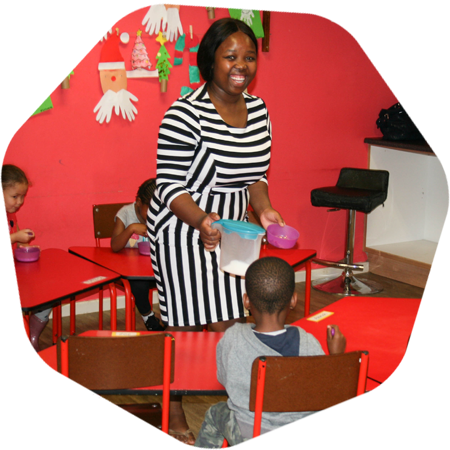
Orange Group: Turning Five
In their pre-Grade R year, we prepare the orange groupers for their big step into ‘big school’. Our teachers pride themselves on graduating Earlybirders who begin Grade R with a head start — ready to catch the worm!
Enrol my child now
Orange Group Daily Routine:

Special supports for Orange Group children and families:
- Developing logic and reasoning skills
- Getting ready for Grade-R
Development and Learning Objectives for the Orange Group:
Language, Literacy and Creative Expression
Maths and Scientific Reasoning
Physical, Social and Emotional well-being
 Language, literacy and creative expression
Language, literacy and creative expression
Engages in music, art and dramatic play
1g. Effectively uses art materials (such as crayons, paint, play dough etc.) to create representations of real / imagined objects, people, scenes
Receptive & Expressive vocabulary development
2j. Shows mastery in using the unit specific vocabulary in context
Coherent expression of personal ideas, thoughts, feelings
3g. Successfully engages in meaningful multi-exchange conversations with peers and adults
Response to Text
4e. Makes predictions about characters and events based on illustrations and discussion prompts from teacher.
Phonological Awareness
5e. Swaps phonemes (take away the “l” in front of “look” and put in another sound to make a new word)
5f. Identifies the syllables that make up a word
Phoneme-Grapheme Correspondence
6c. Identifies at least two letter/sound character pairs (e.g. lip poppers, tongue tappers, tongue scrapers, lip coolers, tongue coolers, skinny and fat airs)
6d. Correctly associates 3-or-more letters with the sounds they make
Print awareness / concepts
7e. Points to individual words within a written sentence (concept of ‘word in text’)
Tracing, transcription and writing
8c. Writes own name independently
 Maths and Scientific Reasoning
Maths and Scientific Reasoning
Estimation
9b. Conceptually subitizes (quickly and accurately estimates the number of objects in a group) up to 6
Verbal and object counting
10f. Counts correctly across different arrangements, keeps track of objects not counted, understands ‘one more’ as after and ‘one less’ as before; “counter”
Numeral recognition, depiction and quantity correspondence (cardinality)
11e. Numeral depiction from 10 to 20
11f. Expanded cardinality (up to 20)
Relative Magnitude and Measurement
12e. Indicates relative magnitude of three quantities
Shape recognition and manipulation
13e. Draws composite shape diagrams independently
13f. Identifies and engages with symmetry
Position, Direction, Orientation, and Time
14g. Demonstrates understanding of ‘to the left of’ , ‘to the right of’
14h. Understands the effect of orientation and distance on perspective (i.e. the fact that objects appear smaller from further away and larger from below)
14i. Differentiates between ‘first’, ‘second’, ‘third’, ‘at the front’, ‘in the middle’, ‘at the back’ of a row of items
Position, Direction, Orientation, and Time
14g. Demonstrates understanding of ‘to the left of’ , ‘to the right of’
14h. Understands the effect of orientation and distance on perspective (i.e. the fact that objects appear smaller from further away and larger from below)
14i. Differentiates between ‘first’, ‘second’, ‘third’, ‘at the front’, ‘in the middle’, ‘at the back’ of a row of items
Classification and Repeat Patterning
15d. Identifies and continues a-bb-a-bb / abc-abc-abc / ab-ac-ab-ac style patterns
Planning
16d. Describes and performs tasks in sequence
Hypothesis formation
17e. Anticipates and avoids negative consequences (full grasp of cause and effect)
 pHysical and social emotional wellbeing
pHysical and social emotional wellbeing
Self-regulation
18k. Collaborates with partner or group members in pair or small group activities
Response to expectations
19g. Can make sense of general instructions such as, ‘let’s tidy up’ (do not need highly detailed instructions) and can discern which element of an instruction does or does not require action on their part
Persistence in the face of challenges
21e. Asks for help after multiple attempts at a task or solving a problem do not succeed.
Gross motor coordination
22q. Runs for at least 10 metres